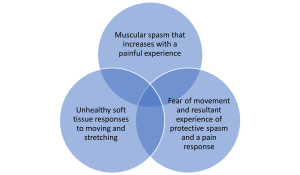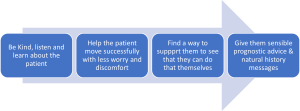The Neck Series: Part 3 “The Stiff Neck”

The final part of this short series looks at a standard unilateral stiff neck with rotation. This is a common problem; it’s one that I have had myself and it really impacted my sport and sleep.
When we see a loss of rotation in one direction, there are clearly many factors that could lead to that. Let’s consider what MSK practitioners would be able to observe or learn about.
Some may ask: what about disc, facet etc, but we can’t be that diagnostic and with no signs of neurological symptoms, it’s not treatment directive to be pathological once red flags are out of the reasoning. In most cases, what practitioners observe is a reduced range of motion associated with muscular responses and pain – and it’s ok to say this as it’s pretty accurate in terms of what we can determine.
We might “feel” where patients indicate the most pain (essentially, we are told where this is by the patient) and we then have to work with the patient to change that relationship to movement.
Using hands-on treatments with exercise has some moderate evidence for its efficacy (Miller et al 2010; Rodriguez-Sanz et al 2020) but we know any hands-on techniques leave a short/moderate term effect only, and of course patients need to be empowered to work towards managing this themselves.

We can’t be sure why hands-on might be helpful as part of an interaction, if at all, but what we can observe is that a patient experiencing something different when they turn their head might happen with an interaction.
Pressing a painful area seems to make patients “feel better” and the context with some sort of diffuse noxious inhibitory response is probably the best I can come up with.
Then patients might move more and feel “less stiffness” – we don’t know what that is, (possibly just reduced muscle spam) but it seems to change with pain. We might advise them to move differently to see if that changes something. There might be something they are doing that is regularly sensitising the tissues or they are in a more sensitised state due to many life factors.
The protective spasm associated with discomfort changes with the variable of treatment and the Treatment is everything that is positively affecting the experience. Positive responses are multi-factorial and no one thing can be identified as correlating the change.
So, it’s a common issue and in many cases self-resolves. Sometimes it doesn’t, and it can affect function and emotions negatively, but keep it simple and practice can improve outcome.

So, in conclusion, my very simple treatment model:

References
Miller, J., Gross, A., D’Sylva, J., Burnie, S.J., Goldsmith, C.H., Graham, N., Haines, T., Brønfort, G. and Hoving, J.L., 2010. Manual therapy and
exercise for neck pain: a systematic review. Manual therapy, 15(4), pp.334-354.
Rodríguez-Sanz, J., Malo-Urriés, M., Corral-deToro, J., López-de-Celis, C., Lucha-López, M.O.,Tricás-Moreno, J.M., Lorente, A.I. and Hidalgo-García, C., 2020. Does the addition of manual therapy approach to a cervical exercise program improve clinical outcomes for patients with chronic neck pain in short-and mid-term? A randomized controlled trial. International journal of environmental research and public health, 17(18), p.6601.